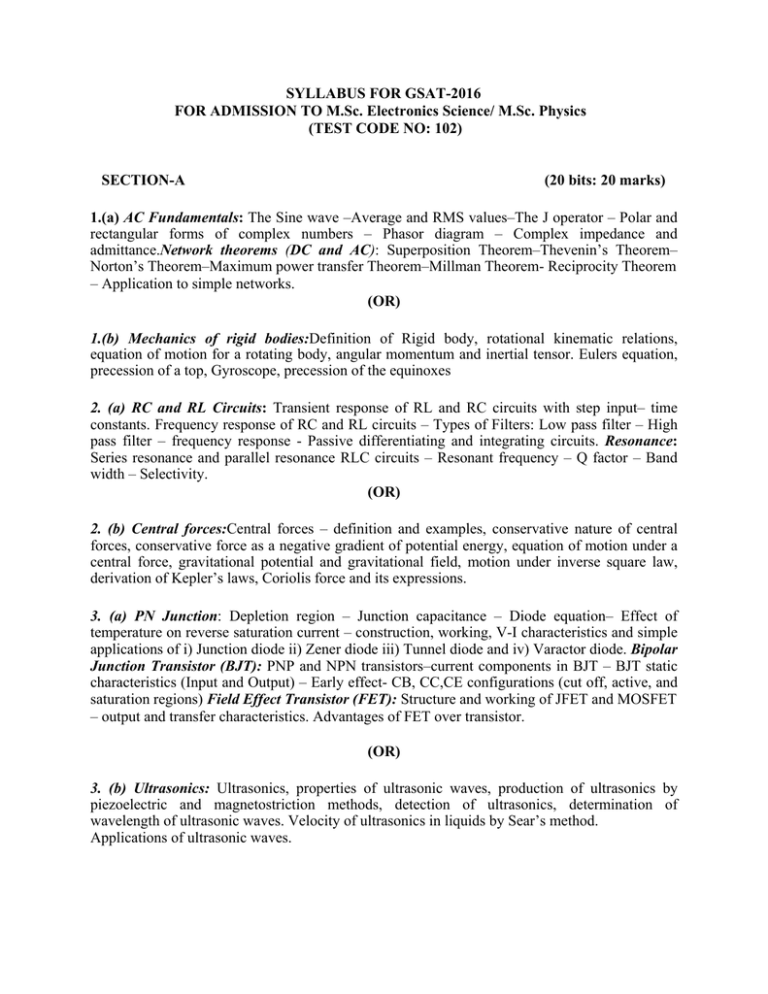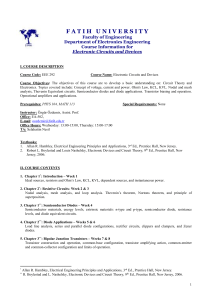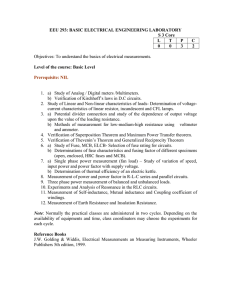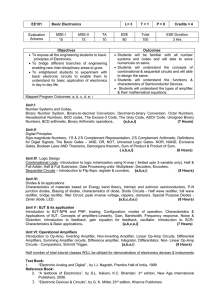TEST CODE NO: 102 - GITAM University
advertisement

SYLLABUS FOR GSAT-2016 FOR ADMISSION TO M.Sc. Electronics Science/ M.Sc. Physics (TEST CODE NO: 102) SECTION-A (20 bits: 20 marks) 1.(a) AC Fundamentals: The Sine wave –Average and RMS values–The J operator – Polar and rectangular forms of complex numbers – Phasor diagram – Complex impedance and admittance.Network theorems (DC and AC): Superposition Theorem–Thevenin’s Theorem– Norton’s Theorem–Maximum power transfer Theorem–Millman Theorem- Reciprocity Theorem – Application to simple networks. (OR) 1.(b) Mechanics of rigid bodies:Definition of Rigid body, rotational kinematic relations, equation of motion for a rotating body, angular momentum and inertial tensor. Eulers equation, precession of a top, Gyroscope, precession of the equinoxes 2. (a) RC and RL Circuits: Transient response of RL and RC circuits with step input– time constants. Frequency response of RC and RL circuits – Types of Filters: Low pass filter – High pass filter – frequency response - Passive differentiating and integrating circuits. Resonance: Series resonance and parallel resonance RLC circuits – Resonant frequency – Q factor – Band width – Selectivity. (OR) 2. (b) Central forces:Central forces – definition and examples, conservative nature of central forces, conservative force as a negative gradient of potential energy, equation of motion under a central force, gravitational potential and gravitational field, motion under inverse square law, derivation of Kepler’s laws, Coriolis force and its expressions. 3. (a) PN Junction: Depletion region – Junction capacitance – Diode equation– Effect of temperature on reverse saturation current – construction, working, V-I characteristics and simple applications of i) Junction diode ii) Zener diode iii) Tunnel diode and iv) Varactor diode. Bipolar Junction Transistor (BJT): PNP and NPN transistors–current components in BJT – BJT static characteristics (Input and Output) – Early effect- CB, CC,CE configurations (cut off, active, and saturation regions) Field Effect Transistor (FET): Structure and working of JFET and MOSFET – output and transfer characteristics. Advantages of FET over transistor. (OR) 3. (b) Ultrasonics: Ultrasonics, properties of ultrasonic waves, production of ultrasonics by piezoelectric and magnetostriction methods, detection of ultrasonics, determination of wavelength of ultrasonic waves. Velocity of ultrasonics in liquids by Sear’s method. Applications of ultrasonic waves. SECTION-B (25 bits: 25 marks) 4. (a) RC Coupled Amplifier: Analysis and frequency response of single stage RC coupled CE amplifier. Feedback: Positive and negative feedback- Effect of feedback on gain, band width, noise, input and output impedances. (OR) 4. (b) Thermodynamics: Introduction – Reversible and irreversible processes – Carnot’s engine and its efficiency – Carnot’s theorem – Second law of thermodynamics, Kelvin’s and Claussius statements – Thermodynamic scale of temperature – Entropy, physical significance – Change in entropy in reversible and irreversible processes – Entropy and disorder – Entropy of universe – Temperature- Entropy (T-S) diagram – Change of entropy of a perfect gas-change of entropy when ice changes into steam. 5. (a) Operational Amplifiers: Differential amplifier- Block diagram of Op-Amp- Ideal characteristics of Op-Amp- Op-Amp parameters- Input resistance- Output resistance- Common mode rejection ratio (CMMR)- Slew rate- Offset voltages – Input bias current- Basic Op-Amp circuits- Inverting Op-Amp- Virtual ground- Non-inverting Op-Amp- Frequency response of OpAmp. Interpretation of Op-Amp .Applications of Op-Amps: Summing amplifier- subtractorVoltage follower- Integrator-Differentiator - Comparator- Logarithmic amplifier. (OR) 5. (b) Quantum theory of radiation: Black body-Ferry’s black body – distribution of energy in the spectrum of Black body – Wein’s displacement law, Wein’s law, Rayleigh-Jean’s law – Quantum theory of radiation - Planck’s law – deduction of Wein’s law, Rayleigh-Jeans law, from Planck’s law - Measurement of radiation – Types of pyrometers – Disappearing filament optical pyrometer – experimental determination – Angstrom pyroheliometer - determination of solar constant, effective temperature of sun. 6. (a) Communications: Need for modulation-Types of modulation- Amplitude, Frequency and Phase modulation. Amplitude modulation-side bands- modulation index- square law diode modulator- Demodulation- diode detector. Frequency modulation working of simple frequency modulator- Ratio detection of FM waves- Advantages of frequency modulation.AM and FM radio receivers. (OR) 6. (b) Optics: Principle of superposition – coherence – temporal coherence and spatial coherence – conditions for Interference of light. Interference by division of wave front. Interference by division of amplitude. Introduction – Distinction between Fresnel and Fraunhoffer diffraction. Resolving Power of grating. Methods of Polarization, Polarizatioin by reflection, refraction, Double refraction, selective absorption , scattering of light – Brewsters law – Malus law – Nicol prism polarizer and analyzer. 7. (a) Power Supplies: Rectifiers– Halfwave, fullwave and bridge rectifiers- Efficiency- Ripple factor- Regulation – Harmonic components in rectified output – Types of filters- Choke input (inductor) filter- Shunt capacitor filter- L section and ∏ section filters – Block diagram of regulated power supply - Series and shunt regulated power supplies. (OR) 7. (b) Laser & Fiber Optics: Lasers: Introduction – Spontaneous emission – Stimulated emission – Population inversion . Laser principle – Einstein coefficients – Types of Lasers – He-Ne laser – Ruby laser – Applications of lasers. Fiber Optics : Introduction – Optical fibers – Types of optical fibers – Step and graded index fibers. SECTION-C (15 bits : 15 marks) 8. (a) Digital Electronics: Introduction to number systems, Logic gates OR, AND, NOT, X-OR, NAND, NOR gates - Truth tables – Positive and negative logic – Logic families and their characteristics – RTL, DTL, ECL, TTL and CMOS.– Universal building blocks NAND and NOR gates. Laws of Boolean algebra De Morgan’s Theorems – Boolean identities – Simplification of Boolean expressions– Karnaugh Maps – Sum of products (SOP) and Product of sums (POS). (OR) 8. (b) Dielectrics: An atomic view of dielectrics, potential energy of a dipole in an electric field. Polarization and charge density, Gauss’s law for dielectric medium– Relation between D,E, and P. Dielectric constant, susceptibility and relation between them. Boundary conditions at the dielectric surface. Electric fields in cavities of a dielectric-needle shaped cavity and disc shaped cavity. 9. (a) Combinational and Sequential circuits: Multiplexer and De-Multiplexer – Decoder, Half adder, Full adder and Parallel adder circuits. Flip flops – RS, D, JK and JK Master-Slave (working and truth tables) - Semiconductor memories – Organization and working- Synchronous and asynchronous binary counters, Up/Down counters- Decade counter (7490) - working, truth tables and timing diagrams. (OR) 9. (b) Moving charge in electric and magnetic field: Hall effect, cyclotron, synchrocyclotron and synchrotron – force on a current carrying conductor placed in a magnetic field, force and torque on a current loop, Biot –Savart’s law and calculation of B due to long straight wire, a circular current loop and solenoid. 10. (a) Introduction to Microcomputer and Microprocessor: Intel 8085 Microprocessor – central processing unit CPU – arithmetic and logic unit ALU – timing and control unit – register organization – address, data and control buses- pin configuration of 8085 and its description. Timing diagrams- Instruction cycle, machine cycle, fetch and execute cycles. Instruction set of 8085, instruction and data formats- classification of instructions –addressing modes. (OR) 10. (b) Electromagnetic induction: Faraday’s law –Lenz’s law – expression for induced emf – time varying magnetic fields – Betatron –Ballistic galvanometer – theory – damping correction – self and mutual inductance, coefficient of coupling, calculation of self inductance of a long solenoid – toroid – energy stored in magnetic field – transformer – Construction, working, energy losses and efficiency. MODEL PAPER 1. According to Stefan Boltzman law, energy emitted by black body is related to temperature as a) (b) (c) 2. The electric field E at centre of uniformly charged conductor is (a) (b) (c) Zero 3. The crystal structure of silicon is (a) Body centered cube (c) Hexagonal close packed (d) (d) (b) Face centered cube (d) Diamond cube





